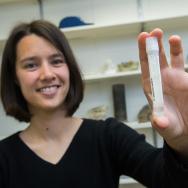The Negev desert, which covers half of Israel’s land mass, is so dry that parts of it get less than three inches of water a year. But beneath it is water that sustains the people and agriculture of the region. Understanding where it came from, how much is there, and what’s happening to it is critical to the security and allocation of that crucial resource.
Researchers at Ben-Gurion University of the Negev in Israel are collaborating with colleagues at the University of Chicago and affiliated Argonne National Laboratory to better understand the Nubian Sandstone Aquifer system, which lies beneath a large portion of the Negev and other parts of Israel.
By combining Argonne’s pioneering radiokrypton dating technique with other isotopic signatures of the water’s composition, the researchers are not only able to tell when that water was deposited, but where it came from and the climate conditions that produced it up to nearly 400,000 years ago. The result, detailed in a new study in the Proceedings of the National Academy of Sciences, marks the first time that scientists have been able to use groundwater to build a picture of the water of ancient climates dating back that far.
“Clean water is vital for sustaining life, and we need to be able to predict future water availability as global warming advances—which depends on understanding water distribution during past warmer and colder periods,” said Reika Yokochi, research associate professor in the Department of Geophysical Sciences at the University of Chicago and the first author of the study. “This project shows us these tools could be really transformative—tracing water movement much further than we’ve previously been able to.”
Trapping atoms for clues
“The aquifers beneath the Negev don’t get replenished today, so apparently there were times when there was much more rain in the region that collected underground,” said Peter Mueller, a physicist with Argonne’s Trapped Radioisotope Analysis Center, or TRACER.
To determine when and how that might have occurred, the team collected water from more than 20 wells in the area, ranging from 900 to 4,850 feet deep. Then, using a device invented in Yokochi’s lab, they separated out the krypton gas and analyzed it using a technology called Atom Trap Trace Analysis (ATTA).
ATTA measures water for traces of the rare isotope krypton-81, which can date water up to 1.5 million years old. This boosts it well beyond the range of radiocarbon dating, which cannot reach accurately beyond about 40,000 years.
The ATTA analysis suggested that the water in the wells accumulated by means of two major “recharging” events—one about 360,000 years ago and one that occurred less than 40,000 years ago. Both periods coincided with generally cooler climates. These “regional humid periods” were ripe for the development of storms that could provide rainfall adequate to replenish the Negev aquifers.
The team paired the krypton-81 analysis with deuterium, an isotope of hydrogen heavier than that found in “regular” water. Because deuterium has a very different mass from hydrogen, it behaves differently during water evaporation, which eventually becomes clouds and rain. When the evaporation happens quickly, as over the Mediterranean Sea, it shows a peculiar signature compared to global precipitation trends.
Thus scientists can “fingerprint” a body of water based on the particular signature of its stable isotopes. Every climate pattern places its own imprint in that signature, the researchers said. This helped them figure out that the complex signature was a result of mixing two different water bodies—as well as when and where they were replenished, and where the water originated.
Divining ancient water
Through this process, the team determined that water from the two recharge events came from two distinct sources. About 400,000 years ago the region was cooler than the present, and moisture is believed to have been delivered from the Atlantic Ocean in the form of tropical plumes. The more recent recharge, less than 40,000 years ago, may have been the result of Mediterranean cyclones during the last time glaciers were at their highest, called the Last Glacial Maximum.
“To our knowledge, this was the first time that groundwater could directly be used as a climate archive on these long timescales,” said Argonne’s Jake Zappala, postdoctoral appointee at the TRACER Center. “Using the radiokrypton dating, we are able to say when it rained, and the heavy-to-light water ratio directly tells us something about the weather pattern. So we have a direct correlation between time and regional weather patterns.”
Another interesting point is that the water came from near an earthquake fault zone, Yokochi said. “This may suggest that faults can serve as a ‘wall’ that preserves relatively fresh water over hundreds of thousands of years,” she said. “It’s possible that similar repositories may exist along other fault zones all over the world.”
To date, getting reliable precipitation data from the past has proven difficult, as is predicting regional changes for climate models in the present. The combination of isotope tools used by the team may be part of the answer to resolving both.
As the tools continue to deliver a more reliable picture of past climate events, like the regional water cycles of the Negev, the researchers believe that this data can serve to calibrate present-day models of similar climate phenomena.
“Does your climate model predict the right precipitation pattern 400,000 years ago?” asked Mueller. “Using our data, modelers can calculate back in time to see if their model is right. That is one of the key things that we can provide.”
Citation: “Radiokrypton unveils dual moisture sources of a deep desert aquifer.” Yokochi et al, Proceedings of the National Academy of Sciences, July 29, 2019. DOI: 10.1073/pnas.1904260116
Funding: Ben Gurion University-Argonne National Laboratory-University of Chicago Collaborative Water Research Initiative, United States-Israel Binational Science Foundation, Israel Water Authority, U.S. Department of Energy, Israel Ministry of Science and Technology, Pratt Foundation.

